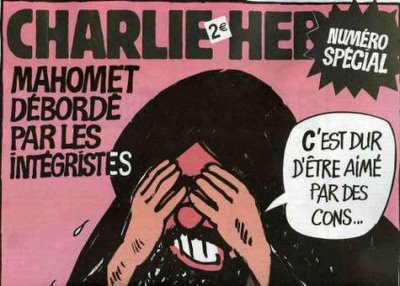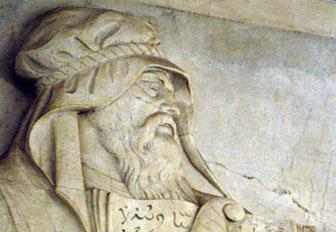The cartoons keep on coming and so do the protests and the violence.
Some European publications are exhibiting their right to freely print what they want. While many nations in Europe are trying to be sensitive to the concerns of Muslims, officials refuse to be kowtowed by angry extremists into censoring the press.
Rhymes With Right has the latest image in the global Cartoon Crisis.

The satirical French weekly Charlie-Hebdo also printed a new drawing under the headline "Muhammad Overwhelmed by the Fundamentalists" that showed the prophet with his head in his hands, remarking, "It's hard to be loved by idiots."
Paris - A French court refused to order the confiscation of a magazine on Tuesday which local Muslim organisations tried to prevent from publishing controversial cartoons of the Prophet Muhammad.
The satirical weekly Charlie-Hebdo was due to publish on Wednesday 12 cartoons originally printed by the Danish paper Jyllens-Posten which have caused outrage in the Muslim world.
"This is good news to us all," Charlie-Hebdo editor Philippe Val told reporters after the ruling.
"We are defending the principle of the right for caricature and satire."
I don't know anything about Val other than what's included in this article -- one sentence.
If he sincerely is defending freedom of expression, then that's admirable. However, if he's exploiting the Cartoon Crisis purely to garner attention for his weekly in the name of personal profit, then he's an opportunist. In that case, the whole thing becomes a self-serving stunt instead of a fearless defense of freedom.
The judges rejected demands by French Muslim organisations, including the French Council of Muslim Faith (CFCM) and the Grand Mosques of Paris and Lyon, which had argued the paper was undermining the principle of the respect of faiths.
The court did not rule on the contents of the claim, but rejected it on a technicality, saying the plaintiffs had failed to follow several points of procedure in filing their suit.
How convenient that the court could throw out the claim on a technicality! Rather than actually having to address the issue, the judges could evade the matter.
I'm sure they were thankful that they didn't have to make a decision that could have prompted Muslim radicals to add them to their hit list.
Sources at Charlie-Hebdo said the weekly's offices and some staff had been placed under police protection ahead of Wednesday's publication, which will also feature a cartoon of Prophet Muhammad burying his face in his hands and saying: "It's hard to be loved by fools".
Obviously, the staff at Charlie-Hebdo feel strongly about standing up for free speech. In spite of the stakes being so high and facing the possibility of physical harm, they are not backing down.
I assume that the weekly will benefit from all the publicity surrounding the matter. Perhaps it's not as much about principle as it is about profit. Nevertheless, whatever the motivation, those at Charlie-Hebdo are making it clear that they will not be censored.
There was an interesting column about the cartoon frenzy in Wednesday's Washington Times by David R. Sands.
He writes:
Lost in the furor over cartoons of the prophet Muhammad is the fact that his likeness has long been portrayed in the collections of some of the world's greatest museums and libraries without exciting alarm or comment.
While rare in the 1,400 years of Islamic art, depictions of Muhammad are found in the collections of such institutions as New York's Metropolitan Museum of Art, the Bibliotheque Nationale de France in Paris and the Edinburgh University library.
Muhammad has been portrayed in the work of revered Muslim artists and of such Western figures as William Blake, Auguste Rodin and Salvador Dali -- as well as the creators of the cable-TV cartoon series "South Park."
None of those depictions aroused the anger seen in reaction to a set of satirical cartoons that appeared in Danish and other European newspapers -- a violent response that continued to roil the Muslim world yesterday.
...Many of the best-known Islamic portrayals of Muhammad are miniatures done in the 14th and 15th centuries by mystical Persian artists who argued that their small, imperfect efforts could never be taken for the actual prophet, and thus were not blasphemous.
...The famous "Book of the Assumption of Muhammad," thought to have been painted around 1436 in Herat, Afghanistan, shows Muhammad mounted on a human-headed horse being led by the Archangel Gabriel on a tour of Paradise and Hell. The original is in the collection of the French Bibliotheque Nationale.
...Even more plentiful are miniatures showing scenes from the life of the prophet with his face and hands covered or his features purposely obscured.
...[Alan A. Godlas, who teaches Islamic studies at the University of Georgia,] compared the Islamic opposition to portraying Muhammad to the reaction of many Protestant churches against the religious imagery and the worship of saints in the Catholic Church.
The great divide in Islam between Shi'ite and Sunni interpretations is reflected in attitudes toward art, said to Islamic scholar Ibrahim Moussawi in Beirut.
"For the most part, Shi'ite Islam has no problem portraying the prophet Muhammad in a respectful manner," he said. "Much Shi'ite art depicts the revered Imams Hussein, Ali and others."
Next time outlets like CNN insist that depicting Mohammed is a horrible affront to Islam, keep this in mind.
The real issue in the global Cartoon Crisis seems to be the lack of respect more than it is the mere portrayal of the prophet. At least some Muslims see it that way.
I think some radical Muslim groups are using the cartoon controversy to flex their muscles. They are seizing the opportunity to get the politically correct lib elitists to submit to their demands.
Not surprisingly, CAIR (Council on American-Islamic Relations) is calling for the removal of Mohammed from books, public buildings, and I suppose milk cartons, too.
Read more about CAIR and its terrorist connections.
Ibrahim Hooper, the spokesman for the group said, "We have expressed the Muslim community's concerns about a variety of images of the Prophet Mohammed, whether it be in textbooks, editorial cartoons or even in the Supreme Court."
Hooper is referring to a marble frieze of Mohammed that has been in the courtroom since the building opened in 1935. The group tried to have it removed, but the court did not capitulate to CAIR's demands.

The prophet of Islam, Muhammad (c.570-632) can be seen on the North Wall Frieze in the Supreme Court courtroom, in Washington DC. Liz O. Baylen (THE WASHINGTON TIMES)
According to Hooper, Muslim leaders still objected to the sculpture but that did not "mean we are going to force our views on others."
Oh, of course not. Who would ever think that some Muslims would attempt to force their views on others?
Right.
Violent protests, riots, embassies in ashes, deaths over cartoons -- Noooo, they wouldn't think of trying to force their views on others, would they?
Tolerance is a two-way street.
To be respected, one should show respect.
The reality is things like torching embassies, committing kidnap, airing tapes of hostages pleading for their lives, and beheading innocents on TV doesn't exactly breed respect.
No comments:
Post a Comment